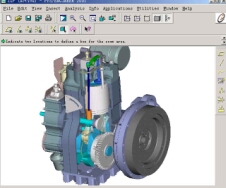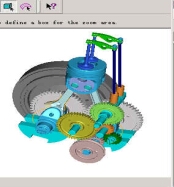1) Parts
[英][pɑ:t] [美][pɑrt]


零部件
1.
Determining parts maintenance cycle by using mathematical statistics;


应用数理统计方法确定设备零部件的维修周期
2.
Enterprise alliance study on automotive parts industry;


汽车零部件行业的企业联盟研究
3.
Weibull fuzzy reliability about vehicle parts;


汽车零部件威布尔模糊可靠度计算
2) Component
[英][kəm'pəʊnənt] [美][kəm'ponənt]


零部件
1.
The natural weathering of material,component and full car;


汽车原材料、零部件、整车自然暴露试验
2.
Design investigation of standard ization、seriation and generalization on some components of auxiliary motors;
辅助电机部分零部件的标准化、系列化、通用化设计探讨
3.
Developments in the Finite Element Technique Application for Engine Components;


发动机零部件有限元技术应用的新进展
3) Components
[英][kəm'pəunənt] [美][kəm'ponənt]


零部件
1.
Optimization model of components supply in remanufacturing system;


再制造系统中零部件供应优化模型
2.
Method for Speeding Fatigue Test of Motor Vehicle Components;


汽车零部件加速疲劳试验方法
3.
The Research of the Squeeze Casting Die Components Standardization;


挤压铸造模具零部件的标准化研究
4) part
[英][pɑ:t] [美][pɑrt]


零部件
1.
Establishment of the User-defined Features Based on Pro/E and Its Application in Automobile Part Design;
基于Pro/E的用户自定义特征及其在汽车零部件设计中的应用
2.
Design of part sub-system based on collaborative product data management;


基于协同产品数据管理理念的零部件子系统的设计
3.
Analysis of state-of-the-art of Auto Parts Industry in Guangxi and Some Suggestions;


广西汽车零部件产业发展现状的分析及建议
5) parts and components


零部件
1.
Reliability analysis of the measurements in the automatic measuring process of rolling stock parts and components;
车辆零部件自动检测中的量值可靠性分析
2.
This article makes an analysis of repair and maintenance system for electric locomotives in Russia, outlines standards and principle in the repair and maintenance system, describes technical diagnosis of the locomotives, and puts forward two restoring approaches for failed or near-failed locomotive parts and components, thus having perfected the condition-based repair and maintenance system.
提出了失效或接近失效机车零部件的两种修复方案 ,完善了状态修体系。
6) parts
[英][pɑ:t] [美][pɑrt]


部件;零件
补充资料:SL1126内燃机零部件数字化建模
1、 SL1126内燃机总成
SL1126内燃机是由机体总成、缸盖总成、运动机构总成,其它机构总成等组成,见图I。
(1)机体总成主要由:机体、油底壳、风扇、油标、同步齿轮室盖、主副曲轴轴承盖、标尺及相应的标准零件。在机体总成中,机体是主要的设计零件。
(2)气缸盖总成主要包括的零件有:气缸盖、缸盖罩、喷油嘴、机油筒、空气滤清器等零件;其中气缸盖是主要设计零件。
(3)运动机构总成由活塞,滑块,活塞销,连杆,连杆配件,主、副曲轴总成,正视齿轮总成,凸轮轴总成以及气门挺杆总成等组成。
(4)其他机构总成有:机油泵总成,喷油泵总成等组成。
SL1126内燃机是由机体总成、缸盖总成、运动机构总成,其它机构总成等组成,见图I。
(1)机体总成主要由:机体、油底壳、风扇、油标、同步齿轮室盖、主副曲轴轴承盖、标尺及相应的标准零件。在机体总成中,机体是主要的设计零件。
(2)气缸盖总成主要包括的零件有:气缸盖、缸盖罩、喷油嘴、机油筒、空气滤清器等零件;其中气缸盖是主要设计零件。
(3)运动机构总成由活塞,滑块,活塞销,连杆,连杆配件,主、副曲轴总成,正视齿轮总成,凸轮轴总成以及气门挺杆总成等组成。
(4)其他机构总成有:机油泵总成,喷油泵总成等组成。

图I SL1126内燃机总成

图II 内燃机运动机构总成
2、自顶向下设计的参数化技术
在CAD中,参数化技术是采用参数预定义的方法建立图形的集合约束集,指定一组尺寸作为参数使其与几何约束集相关联,并将所有的关联式融入到应用程序中,然后以人机交互方式修改参数尺寸,通过参数化尺寸驱动实现对设计结果的修改。参数化设计过程中,参数与设计对象的控制尺寸有明显的对应关系,并具有全局相关性。参数化设计不同于传统的设计,它储存了设计的整个过程,能设计出一族而非单一的在形状和功能上具有相似性的产品模型。正是有了这种参数化建模技术,才使得数据的改变在不同层次(如不同的子装配系统和不同的零件)之间的传递变得唯一个即时。这样,才有了真正意义上的自顶向下设计及以这种设计为基础的并行设计,后者是团队设计的基础。
下面以主同步齿轮零件三维参数化为例:
下面为渐开线方程:
alpha=20
m=4
z=46
r0=0.5*m*z*cos(20)
t0=t*40
x0=(cos(t0)+t0*pi/180*(sin(t0)))*r0
y0=(sin(t0)-t0*pi/180*(cos(t0)))*r0
theta=-(tan(alpha)-alpha*pi/180)*180/pi-90/z
x=x0*cos(theta)-y0*sin(theta)
y=x0*sin(theta)+y0*cos(theta)
z=0
其中alpha为压力角, m为模数, z为齿数, r0为基圆半径。

图III 齿轮总成
说明:补充资料仅用于学习参考,请勿用于其它任何用途。
参考词条